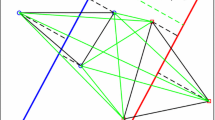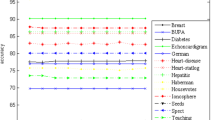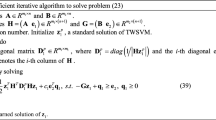Abstract
This paper analyses the performance of combining Support Vector Machines (SVMs) and metric learning, in order to evaluate the effect of metric learning on improving SVM. First, we establish the sufficient condition under which the performance of SVM cannot be improved by metric learning. Second, to verify whether the sufficient condition holds, we develop a two-step metric learning strategy by learning an orthonormal matrix and a diagonal matrix respectively. Third, we analyze the case when the sufficient condition holds after the two-step metric learning, and therefore demonstrate the practicability of improving the accuracy of SVM. Finally, we provide some experiments, and also apply metric learning into SVM for 3D object classification and face recognition. The experimental results demonstrate the effectiveness of improving the SVM classification performance by metric learning.












Similar content being viewed by others
Explore related subjects
Discover the latest articles, news and stories from top researchers in related subjects.References
Baghshah MS, Shouraki SB (2009) Semi-supervised metric learning using pairwise constraints. In: Proceedings of the 21st international joint conference on artificial intelligence. Pasadena, California, USA, pp 1217–1222
Bilenko M, Basu S, Mooney RJ (2004) Integrating constraints and metric learning in semi-supervised clustering. In: Proceedings of the 21st international conference on machine learning. Banff, Alberta, Canada, pp 81–88
Chang C, Lin C (2011) LIBSVM: a library for support vector machines. ACM Trans Intel Syst Technol 2(3):1–27
Collobert R, Bengio S, Williamson C (2001) SVMTorch: support vector machines for large-scale regression problems. J Mach Learn Res 1:143–160
Cortes C, Vapnik V (1995) Support-vector networks. Mach Learn 20(3):273–297
Davis JV, Kulis B, Jain P, Sra S, Dhillon IS (2007) Information-theoretic metric learning. In: Proceedings of the 24th international conference on machine learning. Corvalis, Oregon, USA, pp 209–216
Ding Z, Suh S, Han JJ, Choi C, Fu Y (2015) Discriminative low-rank metric learning for face recognition. In: Proceedings of the 11th IEEE international conference and workshops on automatic face and gesture recognition, vol 1. Ljubljana, Slovenia, pp 1–6
Do H, Kalousis A, Wang J, Woznica A (2012) A metric learning perspective of SVM: on the relation of SVM and LMNN. In: Proceedings of the 15th international conference on artificial intelligence and statistics, vol. 22. San Diego, CA, USA, pp 308–317
Du S, Guo Y, Sanroma G, Ni D, Wu G, Shen D (2015) Building dynamic population graph for accurate correspondence detection. Med Image Anal 26(1):256–267
Gao Y, Ji R, Cui P, Dai Q, Hua G (2014) Hyperspectral image classification through bilayer graph-based learning. IEEE Trans Image Process 23(7):2769–2778
Gao Y, Wang M, Ji R, Wu X, Dai Q (2014) 3D object retrieval with Hausdorff distance learning. IEEE Trans Ind Electron 61(4):2088–2098
Gao Y, Wang M, Zha ZJ, Shen J, Li X, Wu X (2013) Visual-textual joint relevance learning for tag-based social image search. IEEE Trans Image Process 22(1):363–376
Goldberger J, Hinton GE, Roweis ST, Salakhutdinov RR (2005) Neighbourhood components analysis. In: Advances in neural information processing systems 18. MIT Press, Vancouver, Canada. pp 513–520
Hoi SCH, Liu W, Chang S (2010) Semi-supervised distance metric learning for collaborative image retrieval and clustering. ACM Trans Multimed Comput Commun Appl 6(3):1–26
Huang Z, Wang R, Shan S, Chen X (2015) Face recognition on large-scale video in the wild with hybrid Euclidean-and-Riemannian metric learning. Pattern Recog 48(10):3113–3124
Huang Z, Wang R, Shan S, Chen X (2015) Projection metric learning on Grassmann manifold with application to video based face recognition. In: Proceedings of the 28th IEEE conference on computer vision and pattern recognition. Boston, MA, USA, pp 140–149
Joachims T (1998) Making large-scale SVM learning practical. In: Advances in kernel methods-support vector learning. MIT Press, Cambridge, MA, pp 169–184
Joachims T (1998) Text categorization with support vector machines: learning with many relevant features. In: Proceedings of the 10th European conference on machine learning. Dorint-Parkhotel, Chemnitz, Germany, pp 137–142
Joachims T (2006) Training linear SVMs in linear time. In: Proceedings of the 12th ACM conference on knowledge discovery and data mining. Philadelphia, PA, USA, pp 217–226
Khan B, Han F, Wang Z, Masood RJ (2016) Bio-inspired approach to invariant recognition and classification of fabric weave patterns and yarn color. Assem Autom 36(2):152–158
Kulis B (2012) Metric learning: a survey. Found Trends Mach Learn 5(4):287–364
Lee KC, Ho J, Kriegman DJ (2005) Acquiring linear subspaces for face recognition under variable lighting. IEEE Trans Pattern Anal Mach Intel 27(5):684–698
Li H, Jiang T, Zhang K (2006) Efficient and robust feature extraction by maximum margin criterion. IEEE Trans Neural Netw 17(1):157–165
Li S, Fu Y (2013) Low-rank coding with b-matching constraint for semi-supervised classification. In: Proceedings of the 23rd international joint conference on artificial intelligence. Beijing, China, pp 1472–1478
Liu J, Chen S, Tan X, Zhang D (2007) Comments on “efficient and robust feature extraction by maximum margin criterion”. IEEE Trans Neural Netw 18(6):1862–1864
Liu W, Liu J, Ma S, Liu P, Tao D (2010) Semi-supervised sparse metric learning using alternating linearization optimization. In: Proceedings of 16th the ACM conference on knowledge discovery and data mining. Washington, DC, USA, pp 1139–1148
Mahalanobis PC (1936) On the generalized distance in statistics. Proc Natl Inst Sci India 2:49–55
Mei J, Liu M, Karimi HR, Gao H (2014) Logdet divergence-based metric learning with triplet constraints and its applications. IEEE Trans Image Process 23(11):4920–4931
Niu G, Dai B, Yamada M, Sugiyama M (2014) Information-theoretic semi-supervised metric learning via entropy regularization. Neural Comput 26(8):1717–1762
Platt JC (1998) Sequential minimal optimization: a fast algorithm for training support vector machines. Tech. Rep. MSR-TR-98-14, Microsoft Research
Schultz M, Joachims T (2004) Learning a distance metric from relative comparisons. In: Advances in neural information processing systems 17. MIT Press, Vancouver, Canada, pp 41–48
Shen B (2016) Bio-inspired manipulation and robotics. Assem Autom 36(2):109–110
Shi B, Liu J (2015) Nonlinear metric learning for kNN and SVMs through geometric transformations. arXiv:1508.01534 pp 1–9
Shoushtari L, Mazzoleni S, Dario P (2016) Bio-inspired kinematical control of redundant robotic manipulators. Assem Autom 36(2):200–215
Tang Y (2013) Deep learning using linear support vector machines. arXiv:1306.0239 pp 1–6
Wang H, Wang Y, Sun Y, Pu Q, Lu X (2016) On the small fiber-coupled laser controller for animal robot. Assem Autom 36(2):146–151
Wang Q, Yuen PC, Feng G (2013) Semi-supervised metric learning via topology preserving multiple semi-supervised assumptions. Pattern Recog 46(9):2576–2587
Wang Q, Zuo W, Zhang L, Li P (2014) Shrinkage expansion adaptive metric learning. In: Proceedings of the 13th European conference on computer vision. Zurich, Switzerland, pp 456–471
Weinberger KQ, Blitzer J, Saul LK (2006) Distance metric learning for large margin nearest neighbor classification. In: Advances in neural information processing systems 19. MIT Press, Vancouver, Canada, pp 1473–1480
Wolf L, Levy N (2013) The SVM-minus similarity score for video face recognition. In: Proceedings of the 26th IEEE conference on computer vision and pattern recognition. Portland, OR, USA, pp 3523–3530
Xing EP, Jordan MI, Russell SJ, Ng AY (2003) Distance metric learning with application to clustering with side-information. In: Advances in neural information processing systems 15. MIT Press, Vancouver, Canada, pp 521–528
Ying SH, Wen ZJ, Shi J, Peng YX, Peng JG, Qiao H (2017) Manifold preserving: an intrinsic approach for semi-supervised distance metric learning. IEEE Trans Neural Netw Learn Syst. https://doi.org/10.1109/TNNLS.2017.2691005
Zhong G, Huang K, Liu CL (2011) Low rank metric learning with manifold regularization. In: Proceedings of 11th IEEE international conference on data mining. Vancouver, Canada, pp 1266–1271
Acknowledgements
This work is supported by National Science Foundation of China (Nos. 11771276, 11471208, 61731009 and 61273298), and the Open Research Fund of Shanghai Key Laboratory of Multidimensional Information Processing, East China Normal University, China.
Author information
Authors and Affiliations
Corresponding author
Rights and permissions
About this article
Cite this article
Hu, L., Hu, J., Ye, Z. et al. Performance Analysis for SVM Combining with Metric Learning. Neural Process Lett 48, 1373–1394 (2018). https://doi.org/10.1007/s11063-017-9771-7
Published:
Issue Date:
DOI: https://doi.org/10.1007/s11063-017-9771-7




